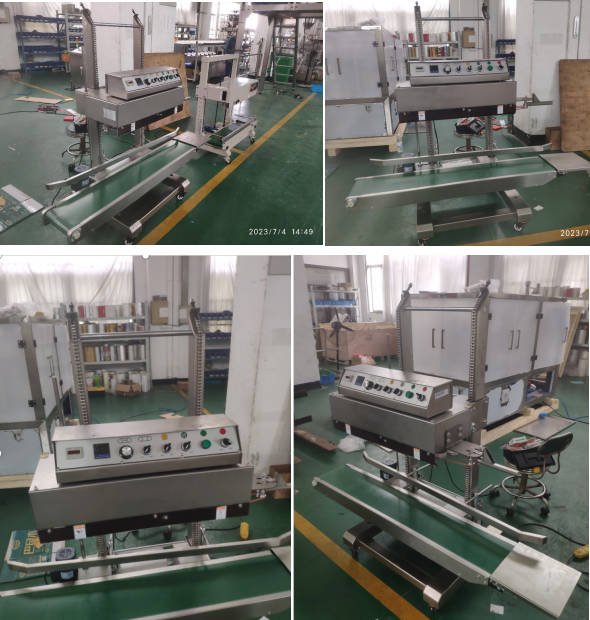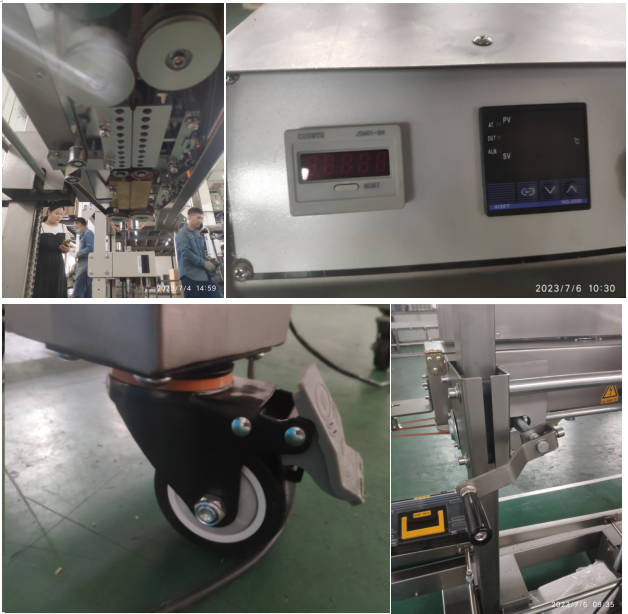The multifunctional automatic film sealing machine is favored by small and medium-sized food processing enterprises due to its ability to seal, stable performance, and good sealing effect. It is also widely used in the production of soft packaging bags. When there are issues with the sealing strength of the edges, middle, or bottom during plastic film bag making, this machine can be used for re-sealing to meet the requirements of heat-sealing quality.
However, after long-term use, especially under working or overloaded conditions, the machine is prone to some electrical and mechanical failures. These include: poor sealing, intermittent operation of the machine, fuse blowing at startup, “squeaking” sounds during operation, uncontrollable temperature, deformation and bending of the finished bags at the sealing point, and the appearance of bubbles or irregular marks at the sealing blade impression. Based on practical usage experience, this article analyzes the causes of several common faults, proposes corresponding solutions, and discusses the maintenance of the sealing machine, hoping to be of help to enterprises and individuals using the machine.
1. Poor Sealing
Poor sealing is one of the common faults of the sealing machine. There are three meanings of poor sealing:
- The packaging bag cannot be sealed at the sealing point.
- Although the bag mouth is sealed under the pressure of the sealing blade, it will split again with a slight squeeze or peel.
- When conducting a peeling test on the sealing point, half of the bag is firmly sealed while the other half is separated. The sealing quality of such a packaging bag is still unqualified because the contents can easily leak during storage and transportation when squeezed. This situation often occurs when the composite lining material is OPP or blown PE.
The causes of the first type of fault are mainly as follows:
- Insufficient heat-sealing temperature. Under normal circumstances, for composite bags with OPP as the lining material and a total thickness of 80-90μm, the heat-sealing temperature should reach 170-180℃. For composite bags with PE as the lining material and a total thickness of 85-100μm, the temperature should be controlled at 180-200℃. As long as the total thickness of the bag increases, the heat-sealing temperature must be correspondingly increased.
- Too fast heat-sealing speed. The inability to seal the bag is also related to the speed of the sealing machine. If the speed is too fast, the sealing point will not have enough time to heat up before it is conveyed to the cooling press by the traction roller for cooling treatment, and naturally, it cannot meet the heat-sealing quality requirements.
- Inappropriate pressure of the cooling press rubber wheel. There is one cooling press rubber wheel on the upper and lower sides, and the pressure between them should be moderate. When adjusting the pressure, just tighten the spring.
- Quality issues with the heat-sealing film. The inability to seal the bag is also related to the quality of the heat-sealing film. If the corona treatment of the composite lining material is uneven and ineffective, and it happens to be at the sealing point, it will definitely not be able to seal the bag. This situation is rare, but once it occurs, the product will be scrapped. Therefore, in the color printing packaging industry, the downstream process supervises the upstream process. Once quality problems are found, the causes must be analyzed and solved in time. If there is moisture or dirt at the sealing point, it will also cause poor sealing. In summary, to solve the first type of poor sealing problem, the heat-sealing temperature can generally be appropriately increased, the heat-sealing speed can be reduced, and the pressure of the cooling press rubber wheel can be increased at the same time.
The causes of the second type of poor sealing fault are mainly as follows:
- Insufficient heat-sealing temperature. The problem can be solved by appropriately increasing the heat-sealing temperature.
- The surface of the heat-sealing blade is not flat. The heat-sealing blade is divided into upper and lower pieces, and a thermocouple is usually installed in it to sense the temperature transfer. There are three screws on the heat-sealing blade, the middle screw supports and reinforces the blade, and the other two screws are equipped with pressure springs and washers, which are mainly used to adjust the pressure of the heat-sealing blade. The upper and lower blades each have two springs. The main reason for the uneven surface of the heat-sealing blade is that the middle screw is not installed horizontally or the pressure of the pressure spring of the upper heat-sealing blade is uneven.
- The solution is to re-correct the position of the middle screw to make it horizontal. If the upper and lower heat-sealing blades are unbalanced, it can be achieved by adjusting the pressure spring to a moderate level. When the spring is pushed outwards, the heat-sealing blade will fall downwards. When the spring of the lower blade is tightened upwards, the heat-sealing blade will move upwards.
- Uneven pressure of the cooling press rubber wheel. Uneven pressure of the cooling press rubber wheel will also cause this type of poor sealing fault, and the solution is similar to the first situation.
The causes of the third type of poor sealing fault are mainly as follows:
- Uneven pressure of the heat-sealing blade or cooling blade. The adjustment of the heat-sealing blade and cooling blade is exactly the same.
- The surface of the heat-sealing blade is not flat. Refer to the corresponding solution for the second type of poor sealing fault.
2. Fuse Blowing
The main motor of the plastic film sealing machine is the first domestic AC motor with a pure aluminum integral worm gear box, which mainly drives the gearbox and the gear transmission of each component. Sometimes, when the sealing machine is started, it will make a “squeaking” sound, cannot operate normally, and even the fuse on the live wire will blow.
To troubleshoot this issue, first check whether the power supply is normal, then cut off the power supply, use the resistance range to measure whether the switch is damaged, and carefully check whether the circuit and motor are short-circuited. Usually, when the motor is short-circuited, the winding is burned out or the wire is broken, the fuse will blow as soon as the sealing machine is started. Another reason for this fault is that the fuse specification is too small. Increasing its specification can solve the problem.
3. “Squeaking” Sound During Operation
This fault occurs during the operation of the sealing machine. The “squeaking” sound often occurs suddenly, followed by uneven sealing speed, which causes poor patterns at the sealing impression of the packaging bag, affecting the appearance quality of the product. Sometimes it can work normally, but it is unpredictable.
This phenomenon is mostly due to mechanical damage or severe wear, as well as poor lubrication. The solution is to mix the same type of engine oil and lubricating grease and add it to the gearbox, then tighten the screws to restore it. After starting the machine, the “squeaking” sound disappears and the sealing returns to normal.
In addition, if the high-temperature belt joint is loose, severely worn, and not clean with dirt on the surface, and it does not synchronize with the traction wheel during operation, it will also make a “squeaking” sound. The solution is to replace the high-temperature belt with the same specification. There is a certain skill in replacing the high-temperature belt. First, compress the pressure wheel spring by hand, then place one end of the high-temperature belt on the rubber wheel, and hold the other end against the other rubber wheel by hand. Set the speed controller to low speed. Once started, relying on the inertia of motion, the high-temperature belt will be automatically installed.
Sometimes the “squeaking” sound is also emitted by the DC shunt motor. It may be due to lack of oil in the motor bearings. If this is the case, the motor should be disassembled and lubricated with oil, and the sound will disappear.
4. Loss of Sealing Temperature Control
This fault is characterized by the malfunction of the temperature gauge, inability to control the temperature, unstable heat-sealing temperature, and the sealing point is either scorched or poorly sealed, with deformed and unattractive sealing. The main cause of this fault is that the thermometer is broken and must be repaired. In addition, the thermocouple may also be broken and cannot normally transmit the sensed temperature to the thermometer. Replacing it with the same type and specification of thermocouple can solve the problem.
From the mechanical aspect, the reason is that the heat-sealing pressure is uneven. As long as the pressure spring of the heat-sealing blade is adjusted to make the pressure consistent, the problem can be solved. At the same time, the contact surface of the heat-sealing blade should be kept clean and free of dirt.
Another reason is that the heat-sealing quality of the composite material itself is not good, and the heat-sealing coefficient changes, causing the temperature it can withstand to be inconsistent.
5. Intermittent Operation of the Sealing Machine
We have encountered the fault of intermittent operation and inconsistent speed of the sealing machine during production. After disassembling the panel on the back of the sealing machine, it was found that the connection between the motor shaft and the gearbox had become loose and detached. Tightening the screws again to make them fit perfectly solved the problem. In addition, the main motor operates through contact with carbon brushes. If the carbon brushes are severely worn, do not make full contact with the slip rings, or have poor friction, the sealing machine will also operate intermittently. Replacing the carbon brushes with the same type of new ones will solve the problem.
6. Bubbles and Irregular Marks at the Sealing Point
This fault is also quite common. Although it does not cause leakage of the packaging, it affects the aesthetics of the packaging and damages the product image.
The main causes of this fault are as follows:
- After long-term use of the equipment, dust and plastic shavings and other dirt adhere to the high-temperature belt, causing the belt to be uneven and irregular. This results in uneven heating at the sealing point. After pressing by the cooling press wheel, bubbles appear. Cleaning or replacing the high-temperature belt can eliminate the fault. The high-temperature belt is generally 1.5 cm wide and about 22μm thick. If it is really impossible to clean the dirt, it has to be scrapped.
- There are irregularly arranged concave and convex marks on the cooling press rubber wheel, which are directly reflected on the packaging, resulting in many obvious marks at the sealing point. To ensure the aesthetic appearance of the packaging bag, it is best to replace the cooling press rubber wheel.
7. Matters to Be Attended to in Equipment Maintenance
- The sealing machine should be placed in a ventilated and dry place, with the room temperature maintained at around 25℃.
- After every 48 hours of operation of the sealing machine, 6# engine oil should be added to each moving part, mainly at the gears, bearings, and gearbox.
- Regular dust removal should be carried out to keep the entire machine clean. When not in use, it is best to unplug the power supply and cover it with a cover.
- If the running time is too long, the cooling fan should be turned on before shutting down the machine. Wait until the temperature drops before turning off the machine. Because if you shut down the machine without cooling, the high-temperature belt is very easy to be damaged.
- The high-temperature belt should be regularly cleaned of dirt to ensure the quality of sealing.
- Severely worn parts should be replaced in time to extend the life of the entire machine.
Post time: Feb-26-2025



